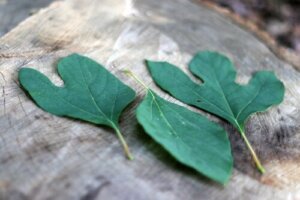Sassafras Tea: Everything You Should Know Before You Try It


Reviewed and approved by the pharmacist Franciele Rohor de Souza
For a long time, the consumption of sassafras tea was popular among those seeking to mitigate certain ailments and infections. In fact, the plant itself is not only used to prepare this beverage, but also to thicken foods and produce a powder that’s often used as a condiment.
However, its use became controversial, as one of its main active compounds – safrole – was found to have potentially toxic effects. What should you know about it? Below, we’ll review its possible benefits, side effects and consumption recommendations. Read on!
What is sassafras tea?
Sassafras tea is a beverage made from the leaves and root parts of the sassafras tree, whose scientific name is Sassafras albidum. This species is native to some regions of North America and East Asia. It’s characterized by its smooth bark and striking greenish-yellow flowers.
The beverage itself has a taste and aroma reminiscent of root beer. This is because the plant was used in the past as a flavoring for root beer. However, in this case, the drink is prepared in the same way as other types of teas.
Simply boil the leaves and root parts in water for 15 to 20 minutes. In this way, the flavors are infused into the liquid and the extracts are concentrated.
The tea is also available in tea bags and concentrates in herbalist stores. It’s advisable to follow the manufacturer’s consumption recommendations.
We think you may also enjoy reading this article: Peppermint Tea: What It’s Used For, Contraindications and Preparation
The uses and possible benefits of sassafras tea
In folk medicine, sassafras tea is associated with analgesic, antimicrobial, antiparasitic and anti-inflammatory properties. So far, only test tube and animal studies have evaluated its potential to contribute to wellness.
However, researchers have determined that more research is needed to consider it as a treatment option in humans. In fact, it’s cautioned that its side effects may outweigh the benefits.
Anti-inflammatory potential
One of the active compounds in sassafras tea, sassarandainol, has been linked to decreased levels of inflammation. In a research reported in Natural Product Research, this substance – together with 10 other compounds of the plant – exhibited anti-inflammatory properties.
Thus, the intake of this beverage is linked to a positive impact on immune function and prevention of chronic diseases. Inflammation is associated with pathologies such as cancer, cardiovascular disorders, and diabetes.

Anti-parasitic properties
In a study shared through Natural Product Communications, sassafras extract showed promising effects as an anti-parasitic. In particular, it helped fight the leishmaniasis parasite, a tropical infectious disease caused by the protozoan Leishmania.
Regarding these effects, evidence is still lacking. Nevertheless, the findings determined that it can kill the parasite without affecting nearby cells.
Anti-diabetic effects
Sassafras tea is not a first-choice treatment for diabetes.
In fact, its use should be done with caution, as the available evidence corresponds to animal studies. In research on rats, reported in Drug Research, the plant showed anti-diabetic potential.
In particular, the active substance called safrole was linked to a decrease in blood glucose levels and an alleviation of insulin resistance. However, the result is controversial, as this substance is also linked to negative health effects.
Diuretic effects
Anecdotal evidence suggests that sassafras tea acts as a natural diuretic. This means that it stimulates the elimination of retained fluids in the tissues, which would improve disorders such as edema and high blood pressure. However, more evidence is still needed.
Other possible benefits of sassafras tea
In traditional medicine, Native Americans used sassafras tea for many other medicinal purposes. These applications even spread to Asia and Europe, where its use also became popular.
According to the U.S. corporation WebMD, purported benefits are as follows:
- Improving digestion
- Reducing a fever
- Urinary health care
- Controlling skin disorders
- Relieving eye swelling
- Treating sprains and bruises
- Preventing insect bites
- Decreasing arthritis and joint disorders
Like this article? You may also like to read: Green Tea, Pineapple and Cinnamon Drink for Weight Loss
The risks and side effects of sassafras tea
In recent decades, the intake of sassafras tea has been a source of controversy, mainly due to evidence of its negative effects. To be more precise, safrole, one of its main active compounds, has been linked to toxic reactions and drug interactions.
In fact, the U.S. Food and Drug Administration (FDA) classified this substance as “prohibited” for addition or direct use as a human food. The reason? Studies link its ingestion to liver cancer and abnormal cell growth.
It has also been linked to negative cardiovascular effects. In particular, research in Toxicology Letters noted that safrole can induce the rupture of plaque deposits in the arteries, contributing to acute cardiac events.
In addition, its use is discouraged during pregnancy, due to the potential risk of miscarriage. It should also not be used during lactation or in young children.
Some possible drug interactions are as follows:
- Lorazepam
- Clonazepam
- Diazepam

Drugs magazine highlights that this plant can lead to side effects, especially when taken in high doses. The most frequent reactions are the following:
- Diaphoresis
- Hot flashes
- Stupor
- Exhaustion
- Tachycardia
- Spasms
- Hallucination
- Paralysis
- Nausea and vomiting
- Dermatitis (for topical use)
- Decrease in body temperature
The presence of these symptoms warns of intoxication. If so, it’s essential to seek immediate medical attention.
What to remember about sassafras
Although sassafras tea is linked to health benefits in folk medicine, the truth is that there’s insufficient evidence to support its safety. On the contrary, studies suggest that its negative effects may have a greater impact on health.
For this reason, the FDA banned its consumption as a food additive and as a supplement. However, it’s possible to find safrole-free varieties of tea on the market. It’s important to check labels, moderate intake, and, in case of illness, consult a doctor first.
All cited sources were thoroughly reviewed by our team to ensure their quality, reliability, currency, and validity. The bibliography of this article was considered reliable and of academic or scientific accuracy.
- Rodman, C. P. (2020). Sassafras. Journal of Clinical Oncology. American Society of Clinical Oncology. https://doi.org/10.1200/JCO.19.01839
-
Hausner, E. A., & Poppenga, R. H. (2013). Hazards Associated with the Use of Herbal and Other Natural Products. In Small Animal Toxicology (pp. 335–356). Elsevier. https://doi.org/10.1016/b978-1-4557-0717-1.00026-0
- Hou YL, Chang HS, Wang HC, Wang SY, Chen TY, Lin CH, Chen IS. Sassarandainol: a new neolignan and anti-inflammatory constituents from the stem of Sassafras randaiense. Nat Prod Res. 2015;29(9):827-32. doi: 10.1080/14786419.2014.988713. Epub 2014 Dec 11. PMID: 25495689.
-
Hunter P. The inflammation theory of disease. The growing realization that chronic inflammation is crucial in many diseases opens new avenues for treatment. EMBO Rep. 2012 Nov 6;13(11):968-70. doi: 10.1038/embor.2012.142. Epub 2012 Oct 9. PMID: 23044824; PMCID: PMC3492709.
-
Pulivarthi D, Steinberg KM, Monzote L, Piñón A, Setzer WN. Antileishmanial Activity of Compounds Isolated from Sassafras albidum. Nat Prod Commun. 2015 Jul;10(7):1229-30. PMID: 26411017.
- Rani S, Sharma S, Kumar S. To investigate antihyperglycemic and antihyperlipidemic potential of safrole in rodents by in-vivo and in-vitro study. Drug Res (Stuttg). 2014 Jun;64(6):287-95. doi: 10.1055/s-0033-1357192. Epub 2013 Oct 16. PMID: 24132706.
- Wile D. Diuretics: a review. Ann Clin Biochem. 2012 Sep;49(Pt 5):419-31. doi: 10.1258/acb.2011.011281. Epub 2012 Jul 10. PMID: 22783025.
- Oh SW, Han SY. Loop Diuretics in Clinical Practice. Electrolyte Blood Press. 2015 Jun;13(1):17-21. doi: 10.5049/EBP.2015.13.1.17. Epub 2015 Jun 30. PMID: 26240596; PMCID: PMC4520883.
- Sassafras – Uses, Side Effects, and More. (n.d.). WebMd. Available in https://www.webmd.com/vitamins/ai/ingredientmono-674/sassafras
- US Deparment of Health and Human Services. (2011). Report on Carcinogens, 15th edition: Polycyclic Aromatic Hydrocarbons : 15 Listings. National Toxicology Program. Retrieved from http://ntp.niehs.nih.gov/go/roc
-
Su L, Zhang H, Zhao J, Zhang S, Zhang Y, Zhao B, Miao J. Safrole-2′,3′-oxide induces atherosclerotic plaque vulnerability in apolipoprotein E-knockout mice. Toxicol Lett. 2013 Feb 27;217(2):129-36. doi: 10.1016/j.toxlet.2012.12.011. Epub 2012 Dec 25. PMID: 23270965.
- Ernst E. Herbal medicinal products during pregnancy: are they safe? BJOG. 2002 Mar;109(3):227-35. doi: 10.1111/j.1471-0528.2002.t01-1-01009.x. PMID: 11950176.
- Sassafras. (Oct 22, 2021). Drugs. Available in https://www.drugs.com/npp/sassafras.html
This text is provided for informational purposes only and does not replace consultation with a professional. If in doubt, consult your specialist.








